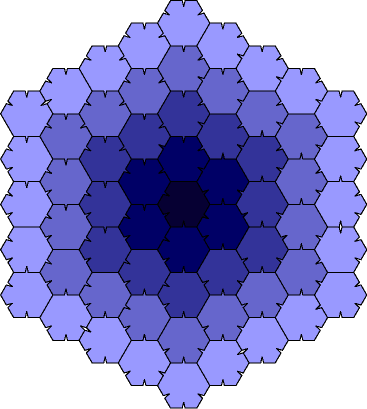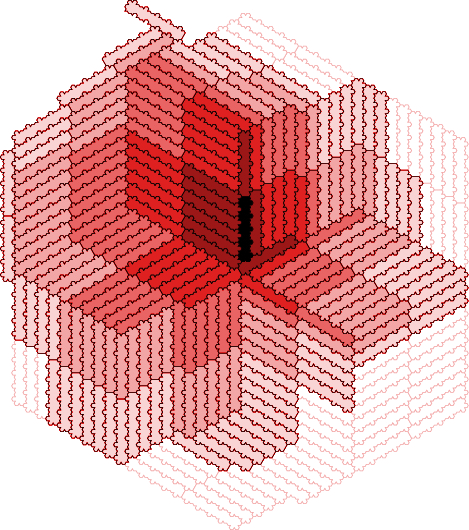More formally, if one has a tiling of the plane (a collection of disjoint connected open sets the closures of which cover the plane), the first corona of a tile is the set of all tiles that have a common boundary point with the tile, including the original tile itself. The second corona is the set of tiles that share a point with something in the first corona, and so on. The Heesch number of a shape is the maximum value of k for which all tiles in the kth corona of any tiling are congruent to that shape.
The Heesch number of a triangle, quadrilateral, regular hexagon, or any other shape that can tile the plane, is infinity. Conversely, an argument based on the axiom of choice shows that a shape with infinite Heesch number must tile the plane. But the Heesch number of a circle is zero, because it can't even be surrounded once by copies of itself without leaving some uncovered space.
Heesch's problem is to determine the largest possible finite Heesch number, or more generally what values other than zero and infinity can occur as the Heesch numbers. For a long time the record holder was a shape found by Robert Ammann, consisting of a regular hexagon with small projections on two sides and matching indentations on three sides. It was believed that this shape had Heesch number three, until in April 2000 Alex Day pointed out that the actual number is four (perhaps this simply reflects a disagreement on the definition of a tiling, since his tiling is not simply connected -- the common boundary of certain pairs of tiles is disconnected).

As can be seen in the picture above, there exist tilings in which copies of the same shape are used all the way out to the fourth corona. One way of proving that this gives the Heesch number of this shape would be to go through a case analysis showing that no fifth-corona tiling is possible.
However a more elegant argument is possible. First note that one can not even produce a single corona without placing the tiles according to the standard hexagonal tiling, with indentations on one tile matched by projections on the adjacent tile. If one could fill the fourth corona this way, it would have 61 hexagons, 122 projections, and 183 indentations, so there would be at least 61 unmatched indentations on the outside boundary of the corona. However the same fourth corona would have only 54 hexagon edges on its outside boundary, which is not enough to hold all those unmatched indentations. Therefore the only way to fill the fourth corona is to match some pairs of indentations with flat sides or each other, forming small holes that prevent the creation of a fifth corona.
If, instead, we had formed a tile with three projections and two indentations per hexagon, the same argument would show that its Heesch number is three.
Other shapes are known with Heesch numbers one or two (see for instance Anne Fontaine, "An infinite number of plane figures with Heesch number two", J. Comb. Th. A 57 (1991) 151-156). Very recently there has been significant progress on the problem: W. R. Marshall found a shape with Heesch number four (formed by indenting and outdenting the union of two hexagons, prior to Day's discovery that Heesch's tile achieves the same number), and Casey Mann has found a similarly indented and outdented pentahex with Heesch number five! (Or maybe even six with the same definition as Day.)

It remains open whether any polygon has higher Heesch number, but these new techniques seem very powerful and likely to lead to further results. Mann writes that that "rounder" polyominoes than the long-skinny ones he's been using may have a better chance of giving unbounded Heesch numbers.
The Heesch number question seems closely connected to two other famous open tiling problems: does there exist an algorithm for determining whether a shape can tile, and does there exist a shape that can only tile aperiodically? Aperiodic tiling seems to act as a barrier to the existence of tiling algorithms, so it is not expected that both of these problems have the same answer. On the other hand, if no finite Heesch number is larger than some k, then it seems that this could be used as the basis of an algorithm to test whether a shape tiles: simply attempt to fill out a tiling to the (k+1)st corona; if successful, the shape must tile the plane, and if not, the shape does not tile.
One can also ask similar questions about Heesch numbers for tilings in higher dimensions, for plane groups other than congruence, or for restricted classes of shapes, however I don't know any answers...
See also:
From the Geometry Junkyard,
computational and recreational geometry.
David Eppstein, Theory Group, ICS, UC
Irvine.
Last update: .